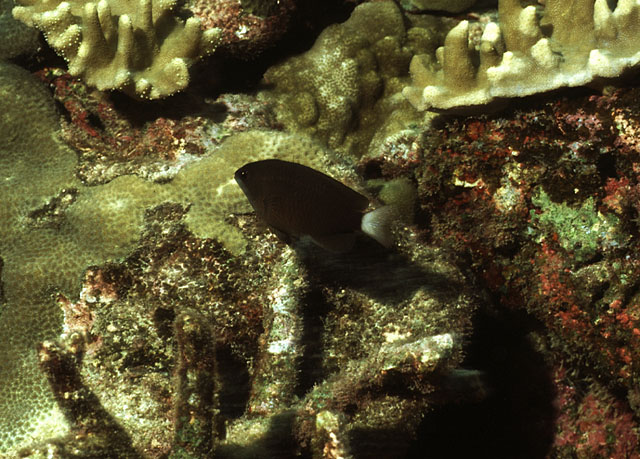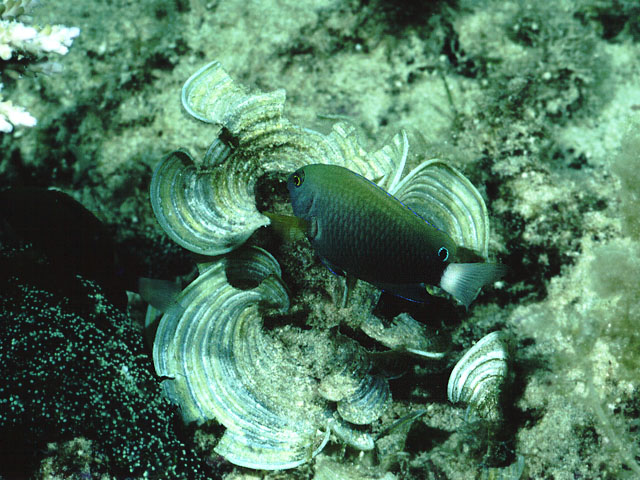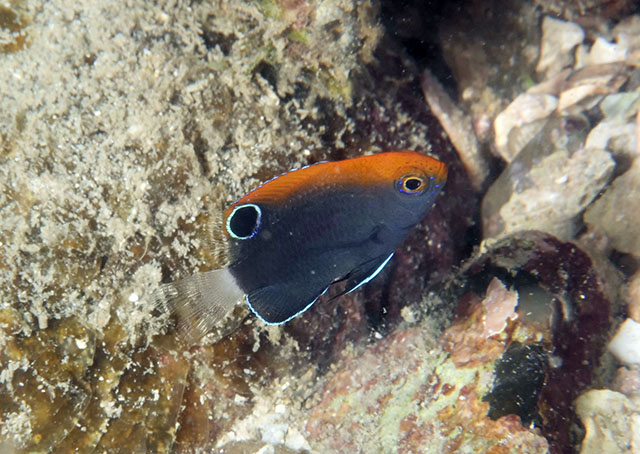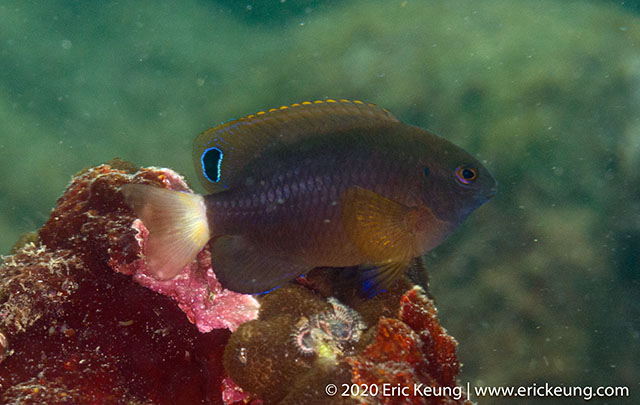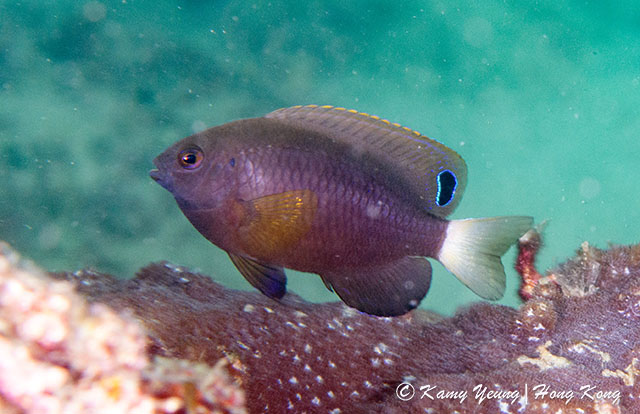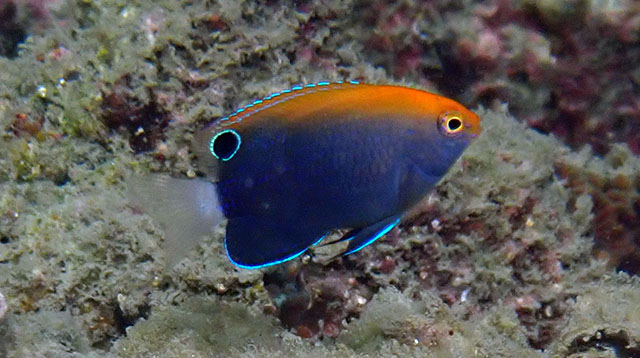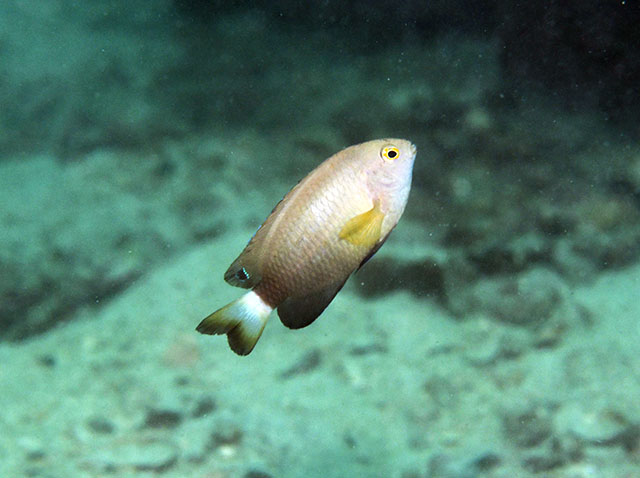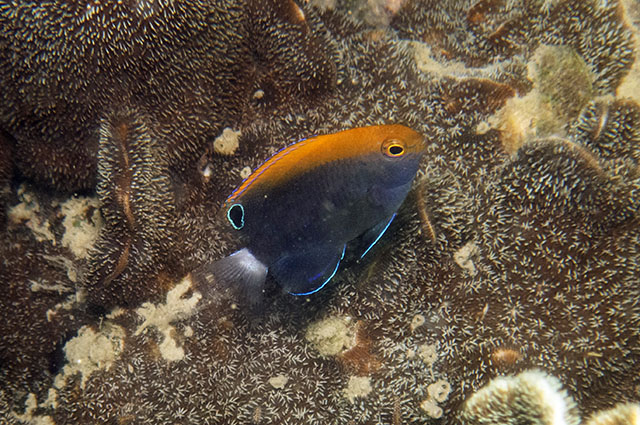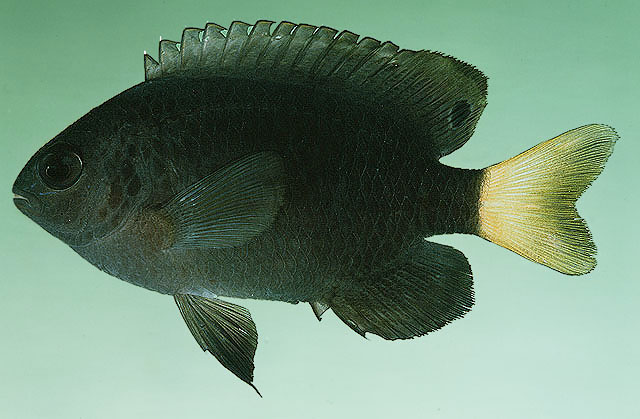Pomacentrus
chrysurus
Cuvier,
1830
Whitetail damsel
View all media / Upload your photos and videos
Expand all
Classification / Names
Teleostei (teleosts) > Ovalentaria/misc (Various families in series Ovalentaria) >
Pomacentridae (Damselfishes)
> Pomacentrinae
Etymology: Pomacentrus: Greek, poma, -atos = cover, operculum + Greek, kentron = sting (Ref. 45335).
More on author:
Cuvier.
Environment / milieu / depth range / climate zone / distribution range
Marine; reef-associated; non-migratory; depth range 0 - 5 m (Ref. 86942); tropical; 30°N - 23°S -.
Distribution
Western Pacific: Christmas Island in the eastern Indian Ocean to the Solomon Islands, north to Ryukyu Islands, south to New Caledonia.
Maps

Pomacentrus chrysurus / Native range
AquaMaps Data sources:
GBIF
OBIS
This map was computer-generated and has not yet been reviewed.

Pomacentrus chrysurus / Suitable habitat
AquaMaps Data sources:
GBIF
OBIS
This map was computer-generated and has not yet been reviewed.

Pomacentrus chrysurus / Point map
AquaMaps Data sources:
GBIF
OBIS
This map was computer-generated and has not yet been reviewed.

Pomacentrus chrysurus / Year 2050
AquaMaps Data sources:
GBIF
OBIS
This map was computer-generated and has not yet been reviewed.
Size / Weight / Age
Max length: 9.0 cm TL male/unsexed (Ref. 30874).
Short description
Dorsal spines (total): 13; Dorsal soft rays (total): 14 - 16; Anal spines: 2; Anal soft rays: 15 - 16. Description: Variable in color, juveniles bright orange over the back they may persist in some individuals in adults. Tail in adults white, a feature less prominent in young (Ref. 48636). Body depth 1.9-2.2 in SL (Ref. 90102).
Biology
Life cycle and mating behavior
Main reference
Allen, G.R. 1991 Damselfishes of the world. Mergus Publishers, Melle, Germany. 271 p. (Ref. 7247)
IUCN Red List Status (Ref. 125652)
Least Concern (LC); date assessed: September 23 2021
CITES (Ref. 131153)
Not Evaluated
CMS (Ref. 116361)
Not Evaluated
Threat to humans
Harmless
More information
- Countries
- FAO areas
- Ecosystems
- Occurrences
- Introductions
- Stocks
- Ecology
- Diet
- Food items
- Food consumption
- Ration
- Common names
- Synonyms
- Metabolism
- Predators
- Ecotoxicology
- Reproduction
- Maturity
- Spawning
- Spawning aggregation
- Fecundity
- Eggs
- Egg development
- Age/Size
- Growth
- Length-weight
- Length-length
- Length-frequencies
- Morphometrics
- Morphology
- Larvae
- Larval dynamics
- Recruitment
- Abundance
- References
- Aquaculture
- Aquaculture profile
- Strains
- Genetics
- Allele frequencies
- Heritability
- Diseases
- Processing
- Mass conversion
- Vision
- Pictures
- Stamps, Coins Misc.
- Sounds
- Ciguatera
- Speed
- Swim. type
- Gill area
- Otoliths
- Brains
Estimates based on models
Preferred temperature (Ref. 123201): 25.5 - 29.3, mean 28.6 °C (based on 2460 cells).
Phylogenetic diversity index (Ref. 82804): PD50 = 0.5 [Uniqueness, from 0.5 = low to 2.0 = high].
Bayesian length-weight: a=0.02692 (0.01683 - 0.04304), b=3.04 (2.90 - 3.18), in cm total length, based on LWR estimates for this species & Genus-body shape (Ref. 93245).
Trophic level (Ref. 69278): 2.6 ±0.2 se; Based on food items.
Resilience (Ref. 120179): High, minimum population doubling time less than 15 months (Preliminary K or Fecundity.).
Fishing vulnerability (Ref. 59153): Low vulnerability (10 of 100).
Price category (Ref. 80766): Unknown.
Nutrients (Ref. 124155): Calcium = 146 [72, 235] mg/100g; Iron = 0.842 [0.486, 1.444] mg/100g; Protein = 18.2 [17.0, 19.4] %; Omega3 = 0.0977 [, ] g/100g; Selenium = 16.8 [8.9, 33.9] μg/100g; VitaminA = 92.4 [25.3, 323.9] μg/100g; Zinc = 2.06 [1.36, 3.09] mg/100g (wet weight);


